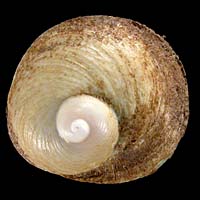|
< Previous family introduction |
|
|||||
 |
Family Calyptraeidae Slipper and Shelf Limpets
|
|||||
|
The Calyptraeidae is a family of molluscs with a flattened shells with expanded aperture and an internal shelf. A coiled spire is always present, but in some species its size is much reduced and the shells appear limpet-like. Some species live in sandy or muddy habitats intertidally, but there are many deeper water species. Most live on solid substrates, but some live on dead bivalves or on the inner lip of gastropods inhabited by hermit crabs, where they take up the shape of the substrate shell. Most are solitary, but some form stacks of shell upon shell, with small males stacked on larger females. Animals in this family are nearly sedentary, capable of slow creeping, but have difficulty reattaching to their substrate when removed. They feed by filtering plankton from the water stream that passes over the gills; the food, enmeshed in mucus, is pulled into the mouth by the radula and consumed. They are consecutive hermaphrodites, male at first then changing to female. Once fertilized by the male, the female broods egg capsules in sacs in the space under the shell, attached to the foot or to the substrate. Embryos hatch as pelagic larvae in some species or as crawling juveniles in others. The biology and taxonomy of the family is well know, due largely to the stimulation of research by an American species, Crepidula fornicata, being introduced to Britain in the 1880s and becoming a serious pest in oyster beds. Hoagland (1977) revised the genus Crepidula, including C. aculeata, a species regarded for at least the last 100 years as having an almost world wide distribution. Collin (2005) investigated C. aculeata and found it to be a complex of at least eight species, differentiated by reproductive characteristics, protoconch form, radula characters and DNA sequences, but impossible to separate on shell characters alone. There are four species of the family in NSW, three of which live subtidally, and have a southern Australian distribution. The fourth species, Bostrycapulus pritzkeri, is one of the species separated out from the Crepidula aculeata complex; although a fairly common intertidal animal, its distribution is as yet unclear. Identification Notes: Shells are low and wide with a small or obsolete spire, and an internal shelf. The shell takes on the shape of the substrate, so the base may be concave, flat or convex. The internal shelf and apex are at the rear of he shell. Family Reference Hoagland, K.E. 1977. Systematic Review of the fossil and recent Crepidula and discussion of evolution of the Calyptraeidae. Malacologica 16(2): 353-420. Coverage All species of the family that occur in NSW are treated here.
|